Software security—the idea of engineering software so that it continues to function correctly under malicious attack—is not really new, but it has received renewed interest over the last several years as reactive network-based security approaches such as firewalls have proven to be ineffective. Unfortunately, today’s software is riddled with both design flaws and implementation bugs, resulting in unacceptable security risk. As Cheswick and Bellovin put it, “any program, no matter how innocuous it seems, can harbor security holes” [Cheswick and Bellovin 1994]. The notion of software security risk has become common knowledge, yet developers, architects, and computer scientists have only recently begun to systematically study how to build secure software.
The network security market weighs in at around $45 billion.[1] However, the 532% increase in CERT incidents reported (2000–2003)[2] and the fact that 43% of 500 companies responding to a popular e-crime survey reported an increase in cybercrime[3] show that whatever we’re doing is clearly not working. Basically, the dollars spent on network security and other perimeter solutions are not solving the security problem. We must build better software.
A body of software security literature has begun to emerge in the research community, but in practical terms the practice of software security remains in its infancy.[4] The first books on software security and security engineering, for example, were published as recently as 2001 [Anderson 2001; Viega and McGraw 2001; Howard and LeBlanc 2002]. Today, a number of references do a good job of providing a philosophical underpinning for software security and discussion of particular technical issues, but much remains to be done to put software security into practice. This book is designed to help.
A central and critical aspect of the computer security problem is a software problem. Software defects with security ramifications—including implementation bugs such as buffer overflows and design flaws such as inconsistent error handling—promise to be with us for years. All too often malicious intruders can hack into systems by exploiting software defects [Hoglund and McGraw 2004]. Moreover, Internet-enabled software applications are a commonly (and too easily) exploited target, with software’s ever-increasing complexity and extensibility adding further fuel to the fire. By any measure, security holes in software are common, and the problem is growing.
The security of computer systems and networks has become increasingly limited by the quality and security of the software running on constituent machines. Internet-enabled software, especially custom applications that use the Web, are a sadly common target for attack. Security researchers and academics estimate that more than half of all vulnerabilities are due to buffer overruns, an embarrassingly elementary class of bugs [Wagner et al. 2000]. Of course, more complex problems, such as race conditions and design errors, wait in the wings for the demise of the buffer overflow. These more subtle (but equally dangerous) kinds of security problems appear to be just as prevalent as simple bugs.
Security holes in software are common. Over the last five years the problem has grown. Figure 1-1 shows the number of security-related software vulnerabilities reported to the CERT Coordination Center (CERT/CC) from 1995 through 2004. There is a clear and pressing need to change the way we approach computer security and to develop a disciplined approach to software security.
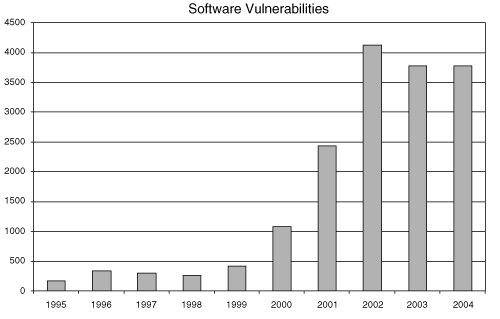
Figure 1-1. The number of security-related software vulnerabilities reported to CERT/CC over several years. Though the widespread adoption of network security technology continues, the problem persists.
Software security is about understanding software-induced security risks and how to manage them. Good software security practice leverages good software engineering practice and involves thinking about security early in the software lifecycle, knowing and understanding common problems (including language-based flaws and pitfalls), designing for security, and subjecting all software artifacts to thorough objective risk analyses and testing. As you can imagine, software security is a knowledge-intensive field.
Software is everywhere. It runs your car. It controls your cell phone. It keeps your dishwasher going. It is the lifeblood of your bank and the nation’s power grid. And sometimes it even runs on your computer. What’s important is realizing just how widespread software is. As businesses and society come to depend more heavily on software, we have to make it better. Now that software is networked by default, software security is no longer a luxury—it’s a necessity.
Most modern computing systems are susceptible to software security problems, so why is software security a bigger problem now than in the past? Three trends—together making up the trinity of trouble—have a large influence on the growth and evolution of the problem.[5]
The growing connectivity of computers through the Internet has increased both the number of attack vectors and the ease with which an attack can be made. This puts software at greater risk. More and more computers, ranging from home PCs to systems that control critical infrastructure, such as the supervisory control and data acquisition (SCADA) systems that run the power grid, are being connected to enterprise networks and to the Internet. Furthermore, people, businesses, and governments are increasingly dependent on network-enabled communication such as e-mail or Web pages provided by information systems. Things that used to happen offline now happen online. Unfortunately, as these systems are connected to the Internet, they become vulnerable to software-based attacks from distant sources. An attacker no longer needs physical access to a system to exploit vulnerable software; and today, software security problems can shut down banking services and airlines (as shown by the SQL Slammer worm of January 2003).
Because access through a network does not require human intervention, launching automated attacks is easy. The ubiquity of networking means that there are more software systems to attack, more attacks, and greater risks from poor software security practices than in the past. We’re really only now beginning to cope with the ten-year-old attack paradigm that results from poor coding and design. Ubiquitous networking and attacks directly related to distributed computation remain rare (though the network itself is the primary vector for getting to and exploiting poor coding and design problems). This will change for the worse over time. Because the Internet is everywhere, the attackers are now at your virtual doorstep.
To make matters worse, large enterprises have caught two bugs: Web Services and its closely aligned Service Oriented Architecture (SOA). Even though SOA is certainly a fad driven by clever marketing, it represents a succinct way to talk about what many security professionals have always known to be true: Legacy applications that were never intended to be inter-networked are becoming inter-networked and published as services.
Common platforms being integrated into megasolutions include SAP, PeopleSoft, Oracle, Informatica, Maestro, and so on (not to mention more modern J2EE and .NET apps), COBOL, and other ancient mainframe platforms. Many of these applications and legacy systems don’t support common toolkits like SSL, standard plug-ins for authentication/authorization in a connected situation, or even simple cipher use. They don’t have the built-in capability to hook into directory services, which most large shops use for authentication and authorization. Middleware vendors pledge they can completely carve out the complexity of integration and provide seamless connectivity, but even though they provide connectivity (through JCA, WBI, or whatever), the authentication and application-level protocols don’t align.
Thus, middleware integration in reality reduces to something ad hoc like cross-enterprise FTP between applications. What’s worse is that lines of business often fear tight integration with better tools (because they lack skills, project budget, or faith in their infrastructure team), so they end up using middleware to FTP and drop data globs that have to be mopped up and transmogrified into load files or other application input. Because of this issue, legacy product integrations often suffer from two huge security problems:
Exclusive reliance on host-to-host authentication with weak passwords
Looming data compliance implications having to do with user privacy (because unencrypted transport of data over middleware and the middleware’s implementation for failover and load balancing means that queue cache files get stashed all over the place in plain text)
Current trends in enterprise architecture make connectivity problems more problematic than ever before.
A second trend negatively affecting software security is the degree to which systems have become extensible. An extensible system accepts updates or extensions, sometimes referred to as mobile code so that the functionality of the system can be evolved in an incremental fashion [McGraw and Felten 1999]. For example, the plug-in architecture of Web browsers makes it easy to install viewer extensions for new document types as needed. Today’s operating systems support extensibility through dynamically loadable device drivers and modules. Today’s applications, such as word processors, e-mail clients, spreadsheets, and Web browsers, support extensibility through scripting, controls, components, and applets. The advent of Web Services and SOA, which are built entirely from extensible systems such as J2EE and .NET, brings explicit extensibility to the forefront.
From an economic standpoint, extensible systems are attractive because they provide flexible interfaces that can be adapted through new components. In today’s marketplace, it is crucial that software be deployed as rapidly as possible in order to gain market share. Yet the marketplace also demands that applications provide new features with each release. An extensible architecture makes it easy to satisfy both demands by allowing the base application code to be shipped early, with later feature extensions shipped as needed.
Unfortunately, the very nature of extensible systems makes it hard to prevent software vulnerabilities from slipping in as unwanted extensions. Advanced languages and platforms including Sun Microsystems’ Java and Microsoft’s .NET Framework are making extensibility commonplace.
A third trend impacting software security is the unbridled growth in the size and complexity of modern information systems, especially software systems. A desktop system running Windows XP and associated applications depends on the proper functioning of the kernel as well as the applications to ensure that vulnerabilities cannot compromise the system. However, Windows XP itself consists of at least forty million lines of code, and end-user applications are becoming equally, if not more, complex. When systems become this large, bugs cannot be avoided.
Figure 1-2 shows how the complexity of Windows (measured in lines of code) has grown over the years. The point of the graph is not to emphasize the numbers themselves, but rather the growth rate over time. In practice, the defect rate tends to go up as the square of code size.[6] Other factors that significantly affect complexity include whether the code is tightly integrated, the overlay of patches and other post-deployment fixes, and critical architectural issues.
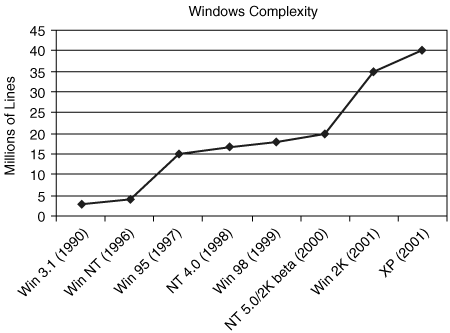
Figure 1-2. Growth of the Microsoft operating system code base from 1990 to 2001. These numbers include all aspects of Windows, including device drivers.[7]
The complexity problem is exacerbated by the use of unsafe programming languages (e.g., C and C++) that do not protect against simple kinds of attacks, such as buffer overflows. In theory, we could analyze and prove that a small program was free of problems, but this task is impossible for even the simplest desktop systems today, much less the enterprise-wide systems used by businesses or governments.
Of course, Windows is not alone. Almost all code bases tend to grow over time. During the last three years, I have made an informal survey of thousands of developers. With few exceptions (on the order of 1% of sample size), developers overwhelmingly report that their groups intend to produce more code, not less, as time goes by. Ironically, these same developers also report that they intend to produce fewer bugs even as they produce more code. The unfortunate reality is that “more lines, more bugs” is the rule of thumb that tends to be borne out in practice (and in science, as the next section shows). Developers are an optimistic lot.
The propensity for software systems to grow very large quickly is just as apparent in open source systems as it is in Windows (see Table 1-1). The problem is, of course, that more code results in more defects and, in turn, more security risk.
Table 1-1. Source Lines of Code for Major Operating Systems and Kernels
Data on this chart gathered by Lee Badger, a DARPA program manager.[8] | ||
|---|---|---|
19xx | SCOMP | 20,000 |
1979 | Multics | 1,000,000 |
2000 | Red Hat 6.2 | 17,000,000 |
2000 | Debian.GNU/Linux 2.2 | 55,000,000 |
2000 | Linux 2.2 kernel | 1,780,000 |
2000 | XFree86 3.3.6 | 1,270,000 |
2001 | Red Hat 7.1 | 30,000,000 |
2002 | Mac OS X Darwin kernel | 790,000 |
[8] Badger reports the Linux estimate from ““Counting Potatoes: The Size of Debian 2.2”” by Gonzalez-Barahona et al. <http://people.debian.org/~jgb/debian-counting>, and ““More Than a Gigabuck: Estimating GNU/Linux’s Size”” by David Wheeler. The Multics estimate is from Tom Van Vleck and Charlie Clingen <http://www.multicians.org/mspp.html>. | ||
Sometimes the code base grows (in executable space) even when the source code base appears to be small. Consider what happens when you target the .NET or J2EE platforms. In these situations, you adopt an unfathomably large base of code underneath your application. Things get even worse when you rely on the following:
Data flattening: Castor, Java Data Objects (JDO), container-managed persistence
Identity management and provisioning
XML or other representational formats and associated parsers
Model View Controller (MVC) frameworks: Struts deployment containers
Application servers, Web containers
Databases: Oracle, SQR, Informatica, and so on
To understand what I mean here, you should think about how much bytecode it takes to run “Hello World” in WebSphere or “Hello World” as a Microsoft ASP glob. What exactly is in that 2MB of stuff running on top of the operating system, anyway?
Everyone believes the mantra “more lines, more bugs” when it comes to software, but until recently the connection to security was understood only intuitively. Thanks to security guru Dan Geer, there are now some real numbers to back up this claim. On his never-ending quest to inject science into computer security, Geer has spoken widely about measurement and metrics. In the now famous monoculture paper, Geer and others decried the (national) security risk inherent in almost complete reliance on buggy Microsoft operating systems (see the acclaimed paper ““CyberInsecurity: The Cost of Monopoly”” [Geer et al. 2003]). Besides being fired from his job at @stake for the trouble, Geer raised some interesting questions about security bugs and the pile of software we’re creating. One central question emerged: Is it true that more buggy code leads to more security problems in the field? What kind of predictive power do we get if we look into the data?
Partially spurred by an intense conversation we had, Geer did some work correlating CERT vulnerability numbers, number of hosts, and lines of code, which he has since presented in several talks. In an address at the Yale Law School,[9] Geer presented some correlations that bear repeating here. If you begin with the CERT data and the lines of code data presented in Figure 1-2 you can then normalize the curves.
Geer describes “opportunity” as the normalized product of the number of hosts (gleaned from publicly available Internet Society data) and the number of vulnerabilities (shown in Figure 1-1). See Figure 1-3. One question to ask is whether there is “untapped opportunity” in the system as understood in this form. Geer argues that there is, by comparing actual incidents curves against opportunity (not shown here). Put simply, there are fewer incidents than there could be. Geer believes that this indicates a growing reservoir of trouble.
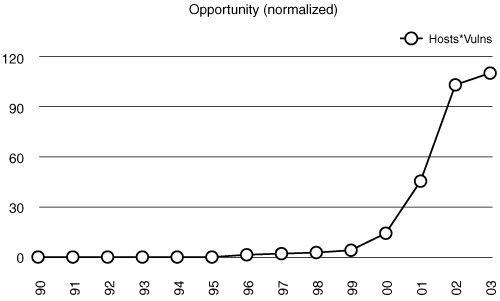
Figure 1-3. Total number of open holes, or “opportunity,” as a normalized product of the number of hosts and the number of vulnerabilities (vulns). (After Geer.)
By normalizing the lines-of-code curve shown in Figure 1-2 against its own median and then performing the same normalization technique on the data in Figure 1-3 as well as data about particular incidents (also from CERT), Geer is able to overlay the three curves to begin to look for correlation (Figure 1-4). The curves fit best when the lines-of-code data are shifted right by two years, something that can be explained with reference to diffusion delay. This means that new operating system versions do not “plonk” into the world all at once in a massive coordinated switchover. Instead, there is a steady diffusion into the operating system population. A two-year diffusion delay seems logical.
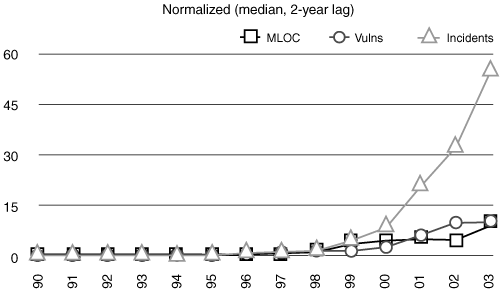
Figure 1-4. Normalized versions of the millions of lines of code, vulnerabilities, and incidents data. Now that we have put these curves together, we can begin to compute curves for correlation and prediction. (After Geer.)
The next step is a bit more complex and involves some rolling average calculation. A code volume curve, which Geer calls MLOCs3 (millions of lines of code smoothed), is computed as the three-year moving average of code volume. A second such curve, called MLOCs3^2+1, is the square of the three-year moving average of code volume shifted right one year. Justification for the squaring operation comes from the commonly accepted rule of thumb that program complexity grows with the square of the number of lines of code. Given the resulting curves (shown in Figure 1-5), Geer argues:
Security faults are a subset of quality faults and the literature says that quality faults will tend to be a function of code complexity, itself proportional to the square of code volume. As such, the average complexity in the field should be a predictor of the attack-ability in an a priori sense. Shifting it right one year is to permit the attack community time to acquire access and skill to that growing code base complexity. This is not a statement of proven causality—it is exploratory data analysis.[10]
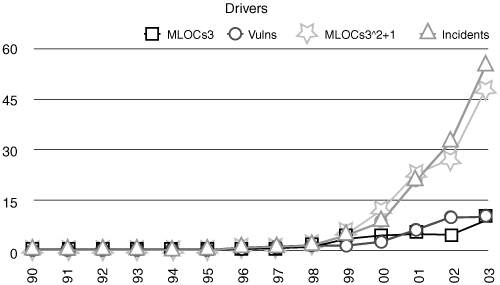
Figure 1-5. Computation of two kinds of code volume curves (MLOCs3 and MLOCs3^2+1; see text for definition) results in curves with some predictive power. (After Geer.)
Geer’s analysis shows that intuitive claims about how growth in simple lines of code metrics correlates with growth in security problems actually hold analytical water.
To boil this all down to one line—more code, more bugs, more security problems.
Software security, that is, the process of designing, building, and testing software for security, gets to the heart of computer security by identifying and expunging problems in the software itself. In this way, software security attempts to build software that can withstand attack proactively.
Though Figure 1-1 clearly shows that the software problem is large, scientists have done little work in classifying and categorizing software security problems.
Perhaps the reintroduction of basic terminology—defect, bug, flaw, and risk—with a security emphasis can help clarify the categorization problem. I propose the following usage.
Defect: Both implementation vulnerabilities and design vulnerabilities are defects. A defect is a problem that may lie dormant in software for years only to surface in a fielded system with major consequences.
Bug: A bug is an implementation-level software problem. Bugs may exist in code but never be executed. Though the term bug is applied quite generally by many software practitioners, I reserve use of the term to encompass fairly simple implementation errors. Bugs are implementation-level problems that can be easily discovered and remedied. An example of a bug is described in the following box—The (Much Ballyhoo’d) Buffer Overflow: An Implementation Bug.
Researchers have made significant progress in detecting security vulnerabilities stemming from low-level and mid-level implementation bugs. Early research tools include FIST [Ghosh, O’Connor, and McGraw 1998], ITS4 [Viega et al. 2000a], Jscan [Viega et al. 2000b], Splint [Evans et al. 1994], Metal [Engler et al. 2000], and Prefix/Prefast [Bush, Pincus, and Sielaff 2000]. Commercial tools (e.g., Fortify Software’s Source Code Analyzer) were introduced to the market in 2005, and development of these tools continues apace. The tools are effective in detecting a wide range of implementation bugs, including buffer overflow vulnerabilities, format string bugs, resource leaks, and simple race conditions—all of which depend on only limited code analysis and knowledge of the external environment. (See Chapter 4 for more on code review and static analysis tool use.)
Flaw: A flaw is a problem at a deeper level. Flaws are often much more subtle than simply an off-by-one error in an array reference or use of an incorrect system call. A flaw is certainly instantiated in software code, but it is also present (or absent!) at the design level. For example, a number of classic flaws exist in error-handling and recovery systems that fail in an insecure or inefficient fashion. Another example can be found in the box, Microsoft Bob: A Design Flaw, that follows. Automated technologies to detect design-level flaws do not yet exist, though manual risk-analysis processes can identify flaws (see Chapter 5).
Table 1-2 provides some simple examples of bugs and flaws. In practice, we find that software security problems are divided 50/50 between bugs and flaws. This means that eradicating bugs through code review will solve only about half of the problem. This may come as a big surprise to those people who believe that software security is exclusively about coding issues. Clearly, it isn’t. Microsoft reports that more than 50% of the problems the company has uncovered during its ongoing security push are architectural in nature [Mike Howard, personal communication]. Cigital data show a 60/40 split in favor of flaws, reflecting Cigital’s specialization in architectural risk analysis.
Table 1-2. Examples of Bugs and Flaws
Bugs | Flaws |
|---|---|
Software security defects come in two basic flavors, each of which accounts for approximately 50% of software security problems. | |
Buffer overflow: stack smashing Buffer overflow: one-stage attacks Buffer overflow: string format attacks Race conditions: TOCTOU Unsafe environment variables Unsafe system calls ( Incorrect input validation (black list vs. white list) | Method over-riding problems (subclass issues) Compartmentalization problems in design Privileged block protection failure ( Error-handling problems (fails open) Type safety confusion error Insecure audit log design Broken or illogical access control (role-based access control [RBAC] over tiers) Signing too much code |
Risk: Flaws and bugs lead to risk. Risks are not failures. Risks capture the probability that a flaw or a bug will impact the purpose of the software (that is, risk = probability × impact). Risk measures must also take into account the potential damage that can occur. A very high risk is not only likely to happen but also likely to cause great harm. Risks can be managed by technical and non-technical means.
Building secure software is like building a house. I liken correct low-level coding (such as using functions likely to cause buffer overflows) to the use of solid bricks as opposed to bricks made of sawdust. The kinds of bricks used are important to the integrity of the house, but even more important (if the goal is to keep bad things out) is having four walls and a roof in the design. The same thing goes for software: Which system calls and libraries are used and how they are used is important, but overall design properties often count for more. In general, software security to date has paid much more attention to bricks than to walls.
Drawing a hard-and-fast distinction between bugs and flaws is nice, but in practice things are much messier. Sometimes determining whether a defect is a flaw or a bug is difficult. That’s because flaws and bugs exist along a continuum of defects. Security defects in software systems range from local implementation errors (e.g., use of the gets() function call in C/C++) to interprocedural interface errors (e.g., a race condition between an access control check and a file operation) to much higher design-level mistakes (e.g., error-handling and recovery systems that fail in an insecure fashion or object-sharing systems that mistakenly include transitive trust issues).
We can consider these defects as defining a large range based on how much program code must be considered to understand the vulnerability, how much detail regarding the execution environment must be known to understand the vulnerability, and whether a design-level description is best for determining whether or not a given vulnerability is present. For example, we can determine that a call to gets() in a C/C++ program can be exploited in a buffer overflow attack without knowing anything about the rest of the code, its design, or the execution environment other than assuming that the user entering text on standard input may be malicious. Hence, a gets() vulnerability can be detected with good precision using a very simple lexical analysis. This kind of approach is the subject of Chapter 4. A taxonomy of low-level coding defects can be found in Chapter 12.
Midrange vulnerabilities involve interactions among more than one location in code. Precisely detecting race conditions, for example, depends on more than simply analyzing an isolated line of code—it may depend on knowing about the behavior of several functions, understanding sharing among global variables, and being familiar with the operating system providing the execution environment.
Design-level vulnerabilities carry this trend further. Unfortunately, ascertaining whether or not a program has design-level vulnerabilities requires great expertise (and is the subject of Chapter 5). This makes finding design-level flaws not only hard to do but particularly hard to automate as well. The problem is that design-level problems appear to be prevalent and are at the very least a critical category of security risk in code.
Consider an error-handling and recovery system. Failure recovery is an essential aspect of security engineering. But it is complicated because it interacts with failure models, redundant design, and defense against denial-of-service attacks. Understanding whether or not an error-handling and recovery system in an object-oriented program is secure, for example, involves figuring out a global property spread throughout many classes in typical design. Error detection code is usually present in each object and method, and error-handling code is usually separate and distinct from the detection code. Sometimes exceptions propagate up to the system level and are handled by the machine running the code (e.g., Java 2 Virtual Machine exception handling). This makes determining whether or not a given error-handling and recovery design is secure quite difficult. The problem is ex-acerbated in transaction-based systems commonly used in commercial e-commerce solutions where functionality is distributed among many different components running on several servers.
Other examples of design-level problems include object-sharing and trust issues, unprotected data channels (both internal and external), incorrect or missing access control mechanisms, lack of auditing/logging or incorrect logging, ordering and timing errors (especially in multithreaded systems), and many others. In order to make progress as a scientific discipline, software security professionals must understand and categorize these sorts of problems in a rigorous way.
Because the idea that software is a major problem in computer security is fairly new, many diverse sets of people are working on the problem. One set of network security practitioners, led by a number of security tools vendors, has worked hard and spent lots of marketing money to coin “application security” as the moniker of choice to describe the software security space. There are a number of reasons to be wary when confronted with application security. Personally, I am a proponent of the term software security over the term application security, especially when discussing the idea of building security in. Here’s why.
One problem is that the term application security means different things to different people. In many circles, it has come to mean the protection of software after it’s already built. Although the notion of protecting software is an important one, it’s just plain easier to protect something that is defect-free than something riddled with vulnerabilities.
Pondering the question, “What is the most effective way to protect software?” can help untangle software security and application security. On one hand, software security is about building secure software: designing software to be secure; making sure that software is secure; and educating software developers, architects, and users about how to build security in. On the other hand, application security is about protecting software and the systems that software runs in a post facto way, only after development is complete. Issues critical to this subfield include sandboxing code (as the Java Virtual Machine does), protecting against malicious code, obfuscating code, locking down executables, monitoring programs as they run (especially their input), enforcing the software-use policy with technology, and dealing with extensible systems.
Application security follows naturally from a network-centric approach to security by embracing standard approaches, such as “penetrate and patch” and input filtering (trying to block malicious input), and by generally providing value in a reactive way. (See the next box—Application Security Testing Tools: Good or Bad?) Put succinctly, application security is based primarily on finding and fixing known security problems after they’ve been exploited in fielded systems, usually by filtering dangerous input on its way to broken software. Software security—the process of designing, building, and testing software for security—identifies and expunges problems in the software itself. In this way, software security practitioners attempt to build software that can withstand attack proactively. Let me give you a specific example: Although there is some real value in stopping buffer overflow attacks by observing HTTP traffic as it arrives over port 80, a superior approach is to fix the broken code in order to avoid the buffer overflow completely.
Another problem I have with the term application security is that it unnecessarily limits the purview of software security. Sure, applications have security problems, with Web-based applications leading the pack. But if you step back a moment, you’ll see that we have a much bigger problem at hand than simply errant Web applications. Ask yourself, what do wireless devices, cell phones, PDAs, browsers, operating systems, routers, servers, personal computers, public key infrastructure systems, and firewalls have in common? The answer is “software.” What an interesting and wide-ranging list. It encompasses everything from consumer devices to infrastructure items to security apparatus itself. We should not be surprised that real attackers go after bad software—no matter where it lives. A myopic focus on “application” code ignores the bigger picture. That’s why I like to call the field software security.
It is important to think about the impact of simple vocabulary choices in large enterprises. When a large organization sets an application development project in motion, it involves lots of diverse groups: systems people, network people, the architecture group, and a whole bevy of application developers. If the security group buys into application security thinking, they’ll likely end up pushing some vendor or product at their applications people (the VB.NET implementers at the bottom of the software food chain). By contrast, software security thinking focuses its scrutiny on both the applications people and those middleware architects responsible for all of the hard-core “services” code that is extremely susceptible to design flaws. (Of course, both application code and the middleware services it relies on can possess bugs.)
Suborganizations like application development and the architecture group are very territorial, and even if the vendor or product chosen as an application security solution does end up finding defects in the application, the people in the cross hairs are likely to pass the buck: “Oh, you need to talk to the architects.” The security ball has a big chance of being dropped in this situation—especially since the architecture and “real” code is usually set in stone and the architects redispatched to other projects before the VB.NET application implementers are even contracted.
One reason that application security technologies, such as application firewalls, have evolved the way they have is because operations people dreamed them up. In most corporations and large organizations, security is the domain of the infrastructure people who set up and maintain firewalls, intrusion detection systems, and antivirus engines (all of which are reactive technologies).
However, these people are operators, not builders. Given the fact that they don’t build the software they have to operate, it’s no surprise that their approach is to move standard security techniques “down” to the desktop and application levels. The gist of the idea is to protect vulnerable things (in this case, software) from attack, but the problem is that vulnerabilities in the software let malicious hackers skirt standard security technologies with impunity. If this were not the case, the security vulnerability problem would not be expanding the way it is. Clearly, this emphasizes the need to get builders to do a better job on the software in the first place. (See the Security versus Software box.)
Protecting a network full of evolving software is difficult, even if the software is not patched every five minutes. If software were in some sense self-protecting (by being designed defensively and more properly tested from a security perspective) or at least less riddled with vulnerabilities, running a secure network could become easier and more cost effective.
In the short run, we clearly—desperately—must make progress on both fronts. But in the long run, we must figure out ways to build easier-to-defend code. Software security is about helping builders do a better job so that operators end up with an easier job.
Software security is an ongoing activity that requires a cultural shift. There is unfortunately no magic tool or just-add-water process that will result in secure software. Software security takes work. That’s the bad news. The good news is that any organization that is developing software, no matter what software development methodology it is following (if any!), can make straightforward, positive progress by following the plan laid out in this book.
Software security naturally borrows heavily from software engineering, programming languages, and security engineering. The three pillars of software security are applied risk management, software security touchpoints, and knowledge (see Figure 1-8). By applying the three pillars in a gradual, evolutionary manner and in equal measure, a reasonable, cost-effective software security program can result. Throughout the rest of this book, I discuss the three pillars and their constituent parts at length.

Figure 1-8. The three pillars of software security are risk management, software security touchpoints, and knowledge.
No discussion about security is complete without considering risk management, and the same holds true for software security. To make risk management coherent, it is useful to draw a distinction between the application of risk analysis at the architectural level (sometimes called threat modeling or security design analysis) and the notion of tracking and mitigating risk as a full lifecycle activity. Architectural risk analysis is a best practice and is one of the central touchpoints (see Chapter 5). However, security risks crop up throughout the software development lifecycle (SDLC); thus, an overall approach to risk management as a philosophy is also important. I will call this underlying approach the risk management framework (RMF).
Risk management is often viewed as a “black art”—that is, part fortune-telling, part mathematics. Successful risk management, however, is nothing more than a business-level decision-support tool: a way to gather the requisite data to make a good judgment call, based on knowledge of vulnerabilities, threats, impacts, and probabilities. Risk management has a storied history. Dan Geer wrote an excellent overview [Geer 1998]. What makes a good software risk assessment is the ability to apply classic risk definitions to software designs in order to generate accurate mitigation requirements.
Chapter 2 discusses an RMF and considers applied risk management as a high-level approach to iterative risk identification and mitigation that is deeply integrated throughout the SDLC. Carrying out a full lifecycle risk management approach for software security is at its heart a philosophy underpinning all software security work. The basic idea is to identify, rank, track, and understand software security risk as the touchpoints are applied throughout the SDLC.
Chapter 5 provides a discussion of architectural risk analysis. In that chapter I briefly introduce some practical methods for applying risk analysis techniques while software is being designed and built. There are many different, established methodologies, each possessing distinct advantages and disadvantages.
On the road to implementing a fundamental change in the way we build software, we must first agree that software security is not security software. This is a subtle point often lost on development people, who tend to focus on functionality. Obviously, there are security functions in the world, and most modern software includes security features; but adding features such as SSL to your program (to cryptographically protect communications) does not present a complete solution to the security problem. Software security is a system-wide issue that takes into account both security mechanisms (such as access control) and design for security (such as robust design that makes software attacks difficult). Sometimes these overlap, but often they don’t.
Put another way, security is an emergent property of a software system. A security problem is more likely to arise because of a problem in a system’s standard-issue part (say, the interface to the database module) than in some given security feature. This is an important reason why software security must be part of a full lifecycle approach. Just as you can’t test quality into a piece of software, you can’t spray paint security features onto a design and expect it to become secure. There’s no such thing as magic crypto fairy dust—we need to focus on software security from the ground up. We need to build security in.
As practitioners become aware of software security’s importance, they are increasingly adopting and evolving a set of best practices to address the problem. Microsoft has carried out a noteworthy effort under its Trustworthy Computing Initiative [Walsh 2003; Howard and Lipner 2003]. (See the next box, Microsoft’s Trustworthy Computing Initiative.) Most approaches in practice today encompass training for developers, testers, and architects; analysis and auditing of software artifacts; and security engineering. In the fight for better software, treating the disease itself (poorly designed and implemented software) is better than taking an aspirin to stop the symptoms. There’s no substitute for working software security as deeply into the development process as possible and taking advantage of the engineering lessons software practitioners have learned over the years.
Figure 1-9 specifies the software security touchpoints (a set of best practices) that I cover in this book and shows how software practitioners can apply the touchpoints to the various software artifacts produced during software development. These best practices first appeared as a set in 2004 in IEEE Security & Privacy magazine [McGraw 2004]. Since then, they have been adopted (and in some cases adapted) by the U.S. government in the National Cyber Security Task Force report [Davis et al. 2004], by Cigital, by the U.S. Department of Homeland Security, and by Ernst and Young. In various chapters ahead, I’ll detail these best practices (see Part II).
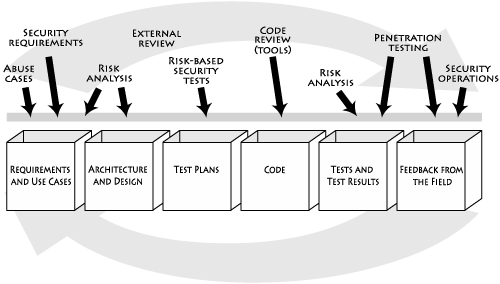
Figure 1-9. Software security best practices applied to various software artifacts. Although in this picture the artifacts are laid out according to a traditional waterfall model, most organizations follow an iterative approach today, which means that best practices will be cycled through more than once as the software evolves.
Note that software security touchpoints can be applied regardless of the base software process being followed. Software development processes as diverse as the waterfall model, Rational Unified Process (RUP), eXtreme Programming (XP), Agile, spiral development, Capability Maturity Model integration (CMMi), and any number of other processes involve the creation of a common set of software artifacts (the most common artifact being code). In the end, this means you can create your own Secure Development Lifecycle (SDL) by adapting your existing SDLC to include the touchpoints. You already know how to build software; what you may need to learn is how to build secure software.
The artifacts I will focus on (and describe best practices for) include requirements and use cases, architecture, design documents, test plans, code, test results, and feedback from the field. Most software processes describe the creation of these kinds of artifacts. In order to avoid the “religious warfare” surrounding which particular software development process is best, I introduce this notion of artifact and artifact analysis. The basic idea is to describe a number of microprocesses (touchpoints or best practices) that can be applied inline regardless of your core software process.[11]
This process-agnostic approach to the problem makes the software security material explained in this book as easy as possible to adopt. This is particularly critical given the fractional state of software process adoption in the world. Requiring that an organization give up, say, XP and adopt RUP in order to think about software security is ludicrous. The good news is that my move toward process agnosticism seems to work out. I consider the problem of how to adopt these best practices for any particular software methodology beyond the scope of this book (but work that definitely needs to be done).
One of the critical challenges facing software security is the dearth of experienced practitioners. Early approaches that rely solely on apprenticeship as a method of propagation will not scale quickly enough to address the burgeoning problem. As the field evolves and best practices are established, knowledge management and training play a central role in encapsulating and spreading the emerging discipline more efficiently. Pillar III involves gathering, encapsulating, and sharing security knowledge that can be used to provide a solid foundation for software security practices.
Knowledge is more than simply a list of things we know or a collection of facts. Information and knowledge aren’t the same thing, and it is important to understand the difference. Knowledge is information in context—information put to work using processes and procedures. A checklist of potential security bugs in C and C++ is information; the same information built into a static analysis tool is knowledge.
Software security knowledge can be organized into seven knowledge catalogs (principles, guidelines, rules, vulnerabilities, exploits, attack patterns, and historical risks) that are in turn grouped into three knowledge categories (prescriptive knowledge, diagnostic knowledge, and historical knowledge).
Two of these seven catalogs—vulnerabilities and exploits—are likely to be familiar to software developers possessing only a passing familiarity with software security. These catalogs have been in common use for quite some time and have even resulted in collection and cataloging efforts serving the security community. Similarly, principles (stemming from the seminal work of Saltzer and Schroeder [1975]) and rules (identified and captured in static analysis tools such as ITS4 [Viega et al. 2000a]) are fairly well understood. Knowledge catalogs only more recently identified include guidelines (often built into prescriptive frameworks for technologies such as .NET and J2EE), attack patterns [Hoglund and McGraw 2004], and historical risks. Together, these various knowledge catalogs provide a basic foundation for a unified knowledge architecture supporting software security.
Software security knowledge can be successfully applied at various stages throughout the entire SDLC. One effective way to apply such knowledge is through the use of software security touchpoints. For example, rules are extremely useful for static analysis and code review activities.
Figure 1-12 shows an enhanced version of the software security touchpoints diagram introduced in Figure 1-9. In Figure 1-12, I identify those activities and artifacts most clearly impacted by the knowledge catalogs briefly mentioned above. More information about these catalogs can be found in Chapter 11.
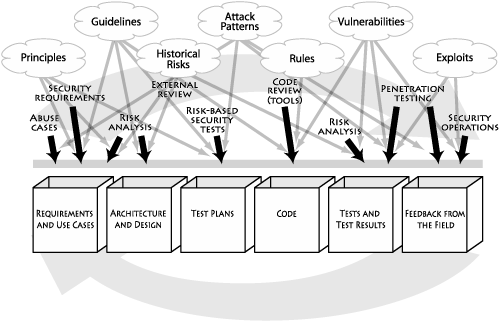
Figure 1-12. Mapping of software security knowledge catalogs to various software artifacts and software security best practices.
Awareness of the software security problem is growing among researchers and some security practitioners. However, the most important audience has in some sense experienced the least exposure—for the most part, software architects, developers, and testers remain blithely unaware of the problem. One obvious way to spread software security knowledge is to train software development staff on critical software security issues.
The most effective form of training begins with a description of the problem and demonstrates its impact and importance. During the Windows security push in February and March 2002, Microsoft provided basic awareness training to all of its developers. Many other organizations have ongoing software security awareness training programs. Beyond awareness, more advanced software security training should offer coverage of security engineering, design principles and guidelines, implementation risks, design flaws, analysis techniques, and security testing. Special tracks should be made available to quality assurance personnel, especially those who carry out testing.
Of course, the best training programs will offer extensive and detailed coverage of the touchpoints covered in this book. Putting the touchpoints into practice requires cultural change, and that means training. Assembling a complete software security program at the enterprise level is the subject of Chapter 10.
The good news is that the three pillars of software security—risk management, touchpoints, and knowledge—can be applied in a sensible, evolutionary manner no matter what your existing software development approach is.
Designers of modern systems must take security into account proactively. This is especially true when it comes to software because bad software lies at the heart of a majority of computer security problems. Software defects come in two flavors—design-level flaws and implementation bugs. To address both kinds of defects, we must build better software and design more secure systems from the ground up.
Most computer security practitioners today are operations people. They are adept at designing reasonable network architectures, provisioning firewalls, and keeping networks up. Unfortunately, many operations people have only the most rudimentary understanding of software. This leads to the adoption of weak reactive technologies (think “application security testing” tools). Tools like those target the right problem (software) with the wrong solution (outside→in testing).
Fortunately, things are beginning to change in security. Practitioners understand that software security is something we need to work hard on. The notion that it is much cheaper to prevent than to repair helps to justify investment up front. In the end, prevention technology and assurance best practices may be the only way to go. Microsoft’s Trustworthy Computing Initiative is no accident.
If we are to build systems that can be properly operated, we must involve the builders of systems in security. This starts with education, where security remains an often-unmentioned specialty, especially in the software arena. Every modern security department needs to think seriously about security engineering. The best departments already have staff devoted to software security. Others are beginning to look at the problem of security engineering. At the very least, close collaboration with the “builders” in your organization is a necessity.
Don’t forget that software security is not just about building security functionality and integrating security features! Coders are likely to ask, “If I use [this API], is it good enough?” when doing their building thing. The question to ask in response is, “What attacks would have serious impact and are worth avoiding for this module?” This line of questioning works to elicit a better understanding of design and its security implications.
Connectivity and distributed computation is so pervasive that the only way to begin to secure our computing infrastructure is to enlist everyone.
Builders must practice security engineering, ensuring that the systems we build are defensible and not riddled with holes (especially when it comes to the software).
Operations people must continue to architect reasonable networks, defend them, and keep them up.
Administrators must understand the distributed nature of modern systems and begin to practice the principle of least privilege.
Users must understand that software can be secure so that they can take their business to software providers who share their values. (Witness the rise of Firefox.) Users must also understand that they are the last bastion of defense in any security design and that they need to make tradeoffs for better security.
Executives must understand how early investment in security design and security analysis affects the degree to which users will trust their products.
The most important people to enlist for near-term progress in computer security are the builders. Only by pushing past the standard-issue operations view of security will we begin to make systems that can stand up under attack.
[1] Network security total market value as reported by the analyst firm IDC in February 2003, Worldwide Security Market <http://www.idc.com/getdoc.jsp?containerId=32391>.
[2] According to data from Carnegie Mellon University’s (CMU) Software Engineering Institute’s (SEI) CERT Coordination Center (shown in Figure 1-1) <http://www.cert.org>.
[3] E-Crime Watch Survey, 2004. Sponsored by CSO Magazine, United States Secret Service, and CMU SEI CERT Coordination Center <http://www.csoonline.com/releases/ecrimewatch04.pdf>.
[4] See Chapter 13 for annotated pointers into the software security literature.
[5] Interestingly, these three general trends are also responsible for the alarming rise of malicious code [McGraw and Morrisett 2000].
[6] See the article ““Encapsulation and Optimal Module Size”” at <http://www.faqs.org/docs/artu/ch04s01.html#ftn.id2894437>.
[7] With regard to particular names for Microsoft operating systems, see <http://foldoc.doc.ic.ac.uk/foldoc/foldoc.cgi?NT5>.
[9] Dan Geer, ““The Physics of Digital Law,”” keynote address, CyberCrime and Digital Law Enforcement Conference, Information Society Project, Yale Law School, March 26, 2004. (Unpublished slides.)
[10] Dan Geer, ““The Physics of Digital Law,”” keynote address, CyberCrime and Digital Law Enforcement Conference, Information Society Project, Yale Law School, March 26, 2004. (Unpublished slides.)
[*] A version of this example first appeared in my “[In]security” column in Network magazine, November 2004. Network magazine is now called IT Architect.
[*] Steve Lipner and Michael Howard ““The Trustworthy Computing Security Development Lifecycle,”” MSDN, March 2005, Security Engineering and Communications, Security Business and Technology Unit, Microsoft Corporation <http://msdn.microsoft.com/library/default.asp?url=/library/en-us/dnsecure/html/sdl.asp>.
[†] The complete Gates memo is included with permission from Microsoft.

![Dave Wagner’s study determined the prevalence of buffer overflows as causes of CERT alerts (around 45%), showing how large a problem such buffer overflows are [Wagner et al. 2000].](http://imgdetail.ebookreading.net/software_development/21/0321356705/0321356705__software-security-building__0321356705__graphics__01fig06.gif)

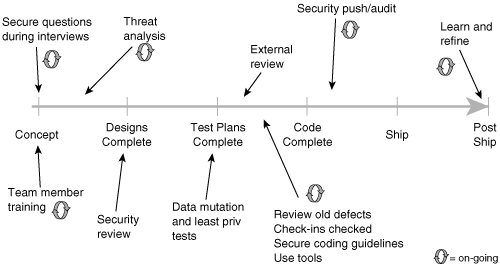
![An updated view of Microsoft’s software security process.[*]](http://imgdetail.ebookreading.net/software_development/21/0321356705/0321356705__software-security-building__0321356705__graphics__01fig11.gif)